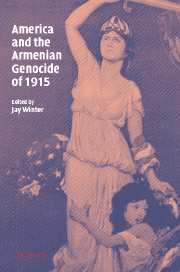Book contents
- Frontmatter
- Contents
- List of contributors
- Map
- Acknowledgments
- Introduction: witness to genocide
- Part 1 The framework
- Part II During the Catastrophe
- 4 A friend in power? Woodrow Wilson and Armenia
- 5 Wilsonian diplomacy and Armenia: the limits of power and ideology
- 6 American diplomatic correspondence in the age of mass murder: the Armenian Genocide in the US archives
- 7 The Armenian Genocide and American missionary relief efforts
- 8 Mary Louise Graffam: witness to genocide
- 9 From Ezra Pound to Theodore Roosevelt: American intellectual and cultural responses to the Armenian Genocide
- Part III After the Catastrophe
- Index
- Studies in the Social and Cultural History of Modern Warfare
6 - American diplomatic correspondence in the age of mass murder: the Armenian Genocide in the US archives
Published online by Cambridge University Press: 04 September 2009
- Frontmatter
- Contents
- List of contributors
- Map
- Acknowledgments
- Introduction: witness to genocide
- Part 1 The framework
- Part II During the Catastrophe
- 4 A friend in power? Woodrow Wilson and Armenia
- 5 Wilsonian diplomacy and Armenia: the limits of power and ideology
- 6 American diplomatic correspondence in the age of mass murder: the Armenian Genocide in the US archives
- 7 The Armenian Genocide and American missionary relief efforts
- 8 Mary Louise Graffam: witness to genocide
- 9 From Ezra Pound to Theodore Roosevelt: American intellectual and cultural responses to the Armenian Genocide
- Part III After the Catastrophe
- Index
- Studies in the Social and Cultural History of Modern Warfare
Summary
The world conflict ignited in August 1914 did not see the immediate departure of the French, British, and Russian Ambassadors in Constantinople. The Triple Entente was at war only against Germany and Austria-Hungary. Its envoys vigorously appealed to the Ottoman Empire to remain neutral. Secretly allied with Germany, the Young Turk government waited to enter the conflict until the end of October. Whether the fate of the Armenians in the Ottoman Empire was sealed in those intervening three months is still debated. What is indisputable is the fact that in November 1914 only one major Western country not aligned with Germany remained with representation at the Sublime Porte, namely the United States of America.
Unlike the European powers, each a colonial empire vying for greater influence in Turkey, the United States had not vested political capital in the Armenian Question. If anything, the United States had stood on the sidelines of the Armenian issue and been engaged only with matters related to humanitarian assistance in response to earlier crises. The United States entertained no territorial ambitions in the Near East. Compared to the level of European involvement in the commercial and financial affairs of the Turkish Empire, US business interests were modest. The US government viewed the entire region as one vast economic space open for American commerce. This too contrasted with European economic policies and practices in the Ottoman Empire with investments concentrated in certain geographic areas or specific fields of commercial endeavor.
- Type
- Chapter
- Information
- America and the Armenian Genocide of 1915 , pp. 146 - 184Publisher: Cambridge University PressPrint publication year: 2004

